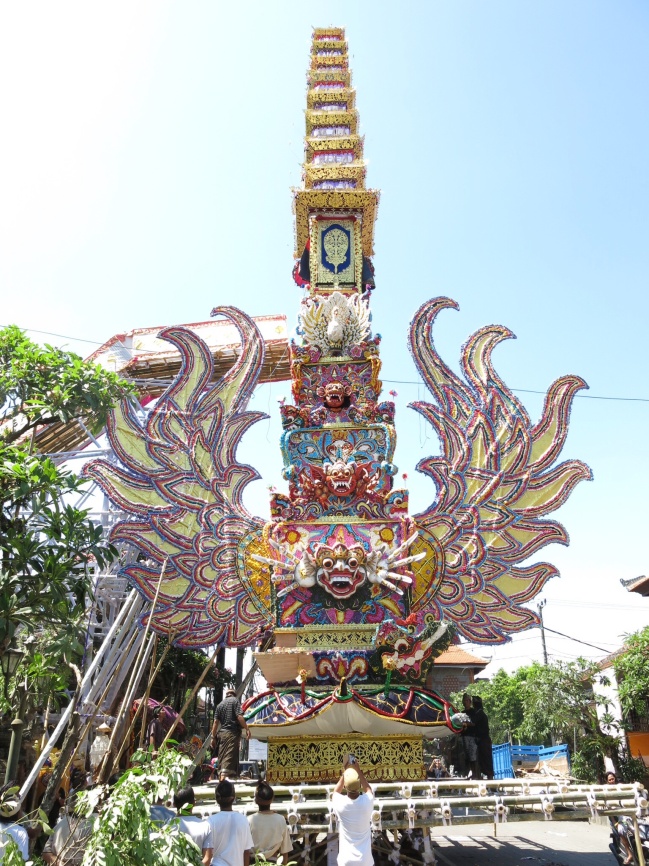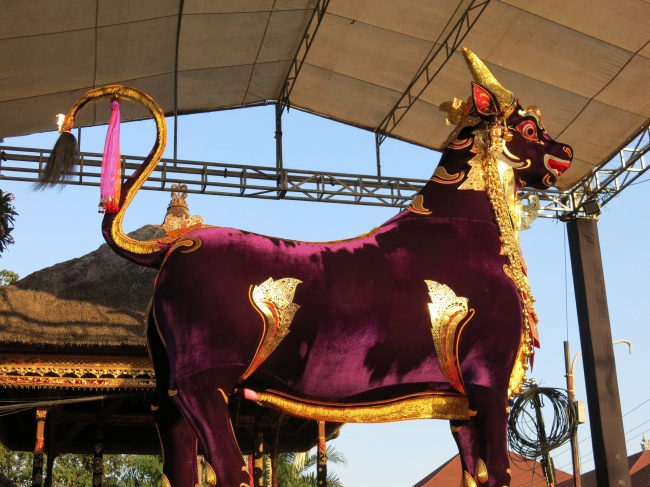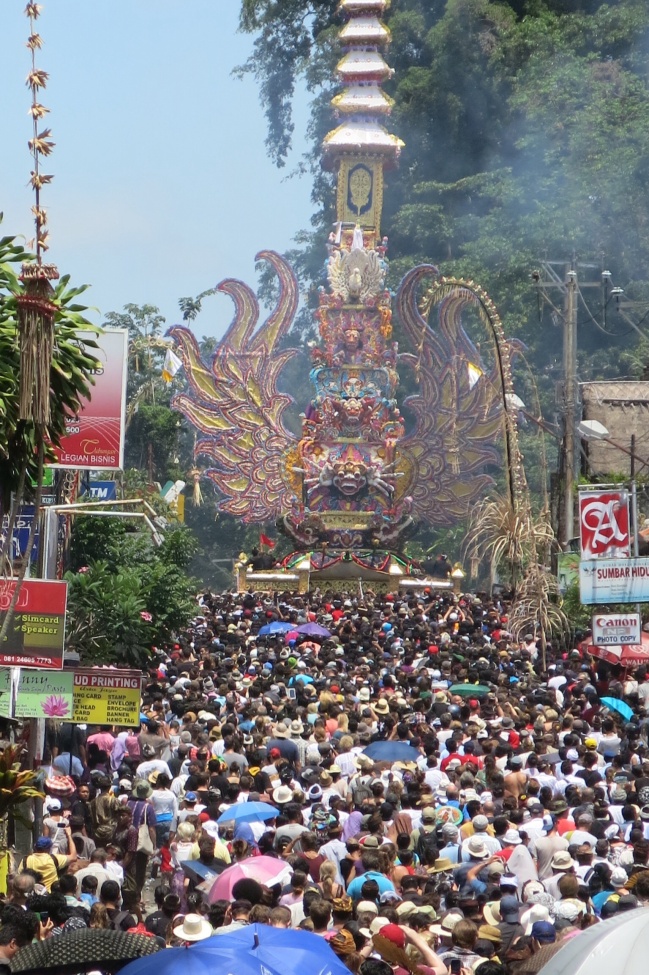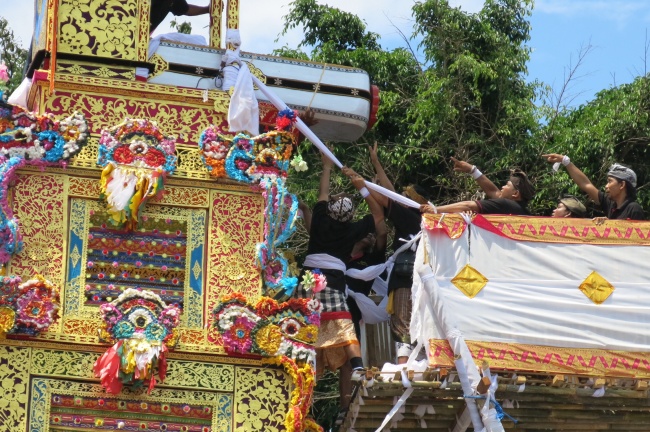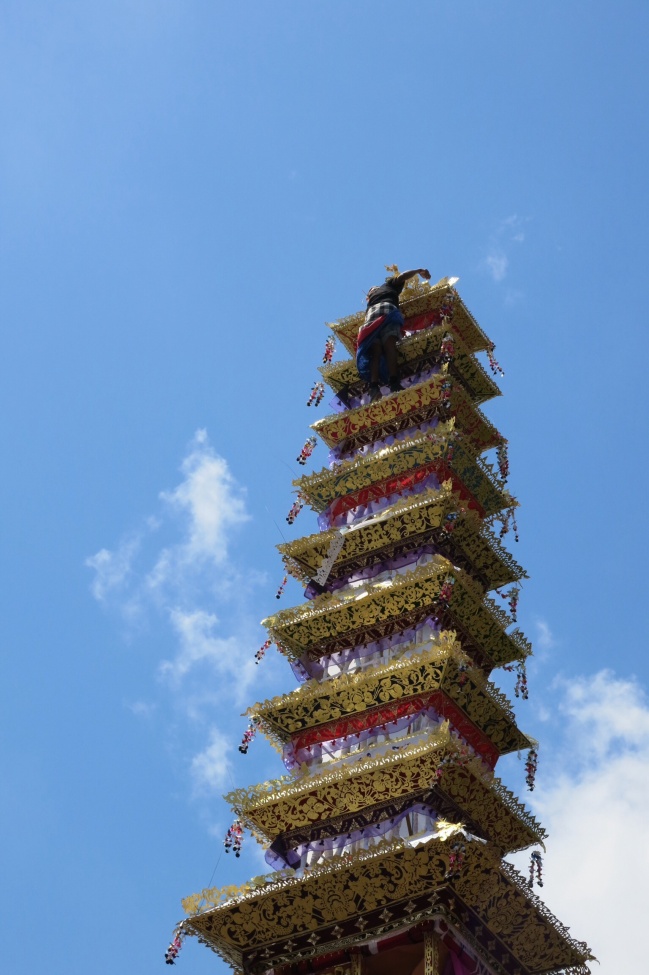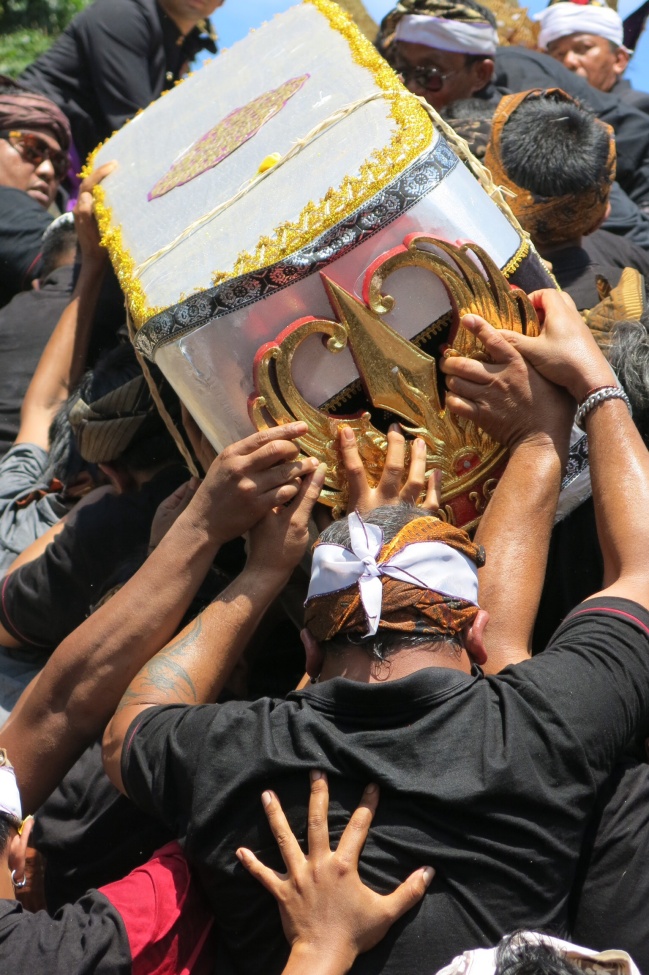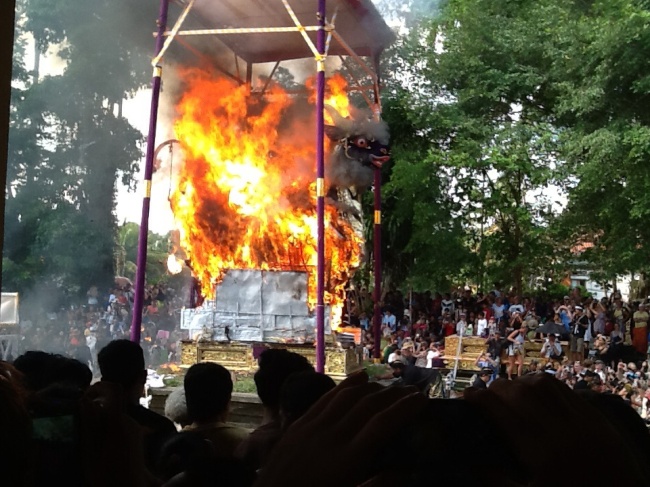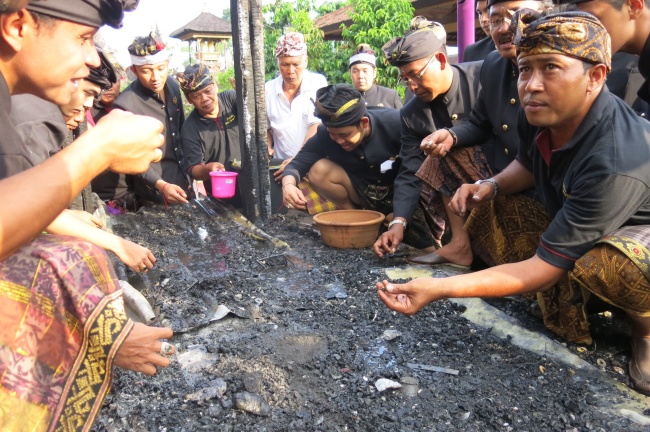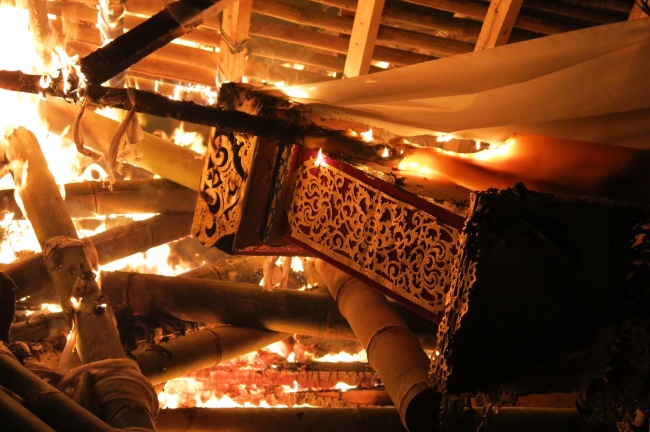Here it is the third day in Ubud, and I’m only starting to recount what has been going on.
I’m a little overwhelmed by all the new stimuli that insist on being noticed: the household shrines that rise above compound walls, the various women, children, men and infirm that sit in front of their little stalls all day long (it’s your life!), the continual flow of motorbikes on streets leading to the center of town from Ketut’s Place where I’m staying…and of course I’m still adjusting to the heat. (I wrote first “debilitating” but it only feels that way; I’ve been able to function pretty well.)
The crush of people, vehicles, bikes, dogs and such that greeted me on entering Ubud on a ride from Sanur beach (with Ketut’s daughter, Madi my driver, studying to be a dentist) made me wonder how I would cope. Upon entering Ketut’s and seeing this marvelous compound that he built from an empty field (one of his family’s rice fields originally) starting in 1989–his life work is clearly visible. The Lonely Planet guide to Ubud calls him a “local luminary” and so he is: member of a kechak (monkey dance) group that performs every Thursday, carrier of traditions even while supporting his 3 children’s education (3 girls, one boy), been to Australia once and Jakarta once, influential in his village and temple affairs…that’s pretty notable for a Balinese and hits all the right notes culturally. The fact he is one of Bali’s portals to the outside world (mostly Northern Europeans staying here, which is fine w/ me) also puts him in an elite local status. More later on Ketut.
The big news for Ubud was the preparations and cremation that took place on Nov. 1st.
I discovered in today’s news (Nov. 2nd) that Getty Images bought the photos and so they are readily viewable around the world. I was in the thick of it all, and spent my first day reconnoitering the route from the central palace–where the body of 59 year old queen-to-be Tjokorda Istri Sri Tjandrawati, late wife of Tjokorda Gde Putra Sukawati, head of Ubud’s ruling family, was placed in a casket and then in a huge tower. The Balinese believe cremation is a purification ceremony that returns Panca Maha Butha (five elements in the universe that formed life) to a new state ready for reincarnation.
The body and casket are placed in a 30+ meter tall, elaborately decorated tower that defies accurate description. The lower tiers have demonic protectors with huge eyes open against any rogue evil forces trying to attack the tower/ritual, while the casket rests in a chamber that has a white phoenix on the outside. Above that is a multi-tiered golden spire with a special flower on top that will become a focus of some drama.
And wings! The morning of the ceremony, two massive wings were attached to the tower, requiring power and telecommunication lines to be cut along the parade route. That enabled the whole thing to travel on the shoulders of men carrying its bamboo foundation…some 400 in all Ketut said, taking turns in teams every 200 meters as covered some 1.5 kilos to the cremation site.
Although the Princess died on Oct. 13, the cremation is being held today in order to maximize auspiciousness. It comes one day before the final day of the Galungan ritual cycle, which occurs every 210 days and marks a time when the spirits of deceased relatives who have died and been cremated return to visit their former homes. The current inhabitants have a responsibility to be hospitable through prayers and offerings. (The most obvious sign of the celebrations are the penjor – bamboo poles placed by the side of the road in front of households and weighed down by offerings suspended at the end.)
The real star of the cremation event is not the showy Tower but a 10 meter tall black bull. Like the Tower, it is built of bamboo and wood but is padded with cotton and then covered with velvet and decorated with gold trim. In the central part of its body is a chamber where the deceased’s body will be placed, then the whole thing set on fire.
So that’s the bare bones of the set-up. Now for the drama.
(Editorial note: no matter how hard a writer tries to convey the intensity of an experience and how articulate s/he might be, we should accept from the start that complexity confounds and must be rendered intelligible via writerly decisions. How much (or little) to say, how to pace the story, how to create vivid characters true to my encounters with them, how to get out of the way and let the events “speak for themselves…” these are all choices to be made. With any luck, the material itself takes over and demands to be rendered just-so, with the writer an intermediary between the reader and the event. This moment, for example, so full of a tropical rainstorm hammering down on ceramic tiles and palm leaves just off my 3rd floor veranda, leaves me speechless and humbled by its power and intensity.)
With the casket placed inside the Tower, the 150 or so men at the bamboo foundation pick it up and give it a massive shake. It’s as if the faces of the demons who protect the Tower’s precious cargo have come awake and challenge all comers. While police roughly push the crowds back to the curbs, and then push people on top of the sidewalks up against the wall (“For Your Safety!”), their whistles blend in with the Tower’s first steps–a pivot mostly, as it turns from in front of the royal palace and towards the cremation site. Getting around that first corner is tricky, as one wing gets dislodged and the foundation and its carriers knock people on the sidewalk around. Seeing this violence, a late-30s American woman beside me is fearful and whimpering and wants to exit, but she’s hemmed in and has nowhere to go. I gently console her that no one will get killed or badly injured, and she’s well protected by a lightpole, so she should hang in there and have a good story to tell her pals later.
Unlike a Japanese festival that generally moves through the street at a fairly sedate pace, the Tower lurches forward quickly and eats up the pavement in 200 meter chunks at a time. I’m just amazed how nimble the whole thing seems to be, even while shredding tree branches and nipping the occasional electric line. Moving quickly is one of many strategies to keep evil spirits confused and off balance.
With Ubud’s sidewalks under perpetual construction, there is no curb to stand on in the middle of the route and so I’m in the street watching the Tower advance. The giant bull and its bearers is further ahead, and at the very front is a contingent of gamelan players, ritual specialists, court attendants with offerings on their heads, and so on, including many members of the royal family decked out in finely tailored black Nehru jackets and sarongs for the men, while the women are in a lacy blue top, skin and undergarments showing through, with a blue skirt highlighted by a red sash belt. Everyone looks elegant and somber, and none of the young men are checking cell phones or engaging in anything but appropriate behavior.
After staying out of the Tower’s way, it rushes past and one of the bearers goes down in front of my eyes. He’s stepped on and knocked unconscious–perhaps he fainted because of the terrific heat and no wind. Several of his colleagues leave their positions to protect him and after clearing the blindly moving feet they have deposited him on the sidewalk, one arm dangling in the garbage of the gutter. Someone is yelling for “water!” and the Tower moves on as the young man is slowly revived.
Once at the Hindu Krishna temple where the cremation will occur, I realize I was given wrong information by an attendant the day before when I went to scope out the logistics. Only the big bull will be burned, while the tower will be pulled apart and burned in pieces. To set the whole thing alight safely would require a space the size of the Burning Man site in the Nevada desert (and in fact, the original inspiration for B.M. came from Bali cremations).
Now that the heavy lifting and fast travel is completed, the next stage requires some dexterity and finesse. The casket is made of heavy teak, lacquered and painted in royal colors, and sits about 50 ft. in the air. It has ridden in the Tower within a façade of a white phoenix… but now the body must be removed from the casket and inserted into the Bull. For this purpose, as for the purpose of installing the casket in the Tower at the start of the procession, a huge scaffold made of bamboo wrapped in white cloth has been constructed. The only trouble is that the scaffold at the cremation temple appears to be about ten feet too low for the casket to roll out of the Tower easily.
And so, high in the air, there is one sure-footed attendant who uses several white cloths to create a support system for the casket so it can be eased into the uplifted hands of colleagues perched on the edge of the scaffolding. I’m surprised to see the man in the tower stepping on the casket, even sitting on it at one point. Perhaps in this case it is function over form, or that a low-caste person could not ritually pollute the remains of a royal person since the latter is so far above the former.
In any case, the casket is removed without mishap and then eased down the steep slope of the scaffold until it is hoisted on the shoulders of people on the ground. As this transition takes place, the person inside the Tower is now climbing to its top. He’s wearing rubber sandals, has a sarong restricting his movements, and of course is not roped in or otherwise protected in any way. Up he goes, tier after tier, until reaching the golden phoenix on the very top–probably 35 meters or about 80 feet in the air. (The average city electric-line pole is around 60 feet, so you get the idea). The phoenix has in its beak a golden flower, which he plucks quickly and tosses to the wind. It is carried to people on the ground where there is a brief scuffle to see who comes up with this auspicious artifact.
All this time I’ve been standing in a crowd of people where we are fully in the sun and there is not a breath of air. I’ve got a hat, sunscreen, a thin Hawaiian shirt and am wearing shorts but feel like I’m being slowly steamed and run the risk of passing out.
So it’s to the Tower base I go where the casket is circumambulating the big bull.
Three times around it goes, preceded by women carrying elaborate offerings on their heads and a number of other ritual participants toting spears for a light-versus-darkness drama to be enacted shortly. Once again, I’m amazed to see regular people (men only) shouldering into place so they can hold the casket for a while as the bull is being prepared. Even a foreign guy with long hair and a nice smile muscles in for a photo op, camera on a pole so he can not only get the distance he needs but do the shutter himself. His t-shirt has a skimpily-clad woman on it but no doubt I’m the only one who noticed.
With considerable pushing and yelling, the casket heads up a smaller scaffold to the big bull. Its top has been sawed open for the transfer of the body. A number of royal family members, perhaps even the daughters and sons of the deceased woman, are on the platform and so shield the body transfer from the eyes of the crowd. When the casket comes back down the scaffold, I can see inside that it was lacquered gold. On the inside of its cover are several diagrams indicating the placement of the corpse and no doubt talismanic concepts protecting the individual.
(And how can I see all this detail? I am sandwiched between the Tower base, the big bull’s scaffold, and the casket procession. I keep waiting to be shooed away but no one says anything and so I’m front-and-center the transfer of the corpse…although to the royal family’s credit, I see nothing even though I’m so close.)
Once the body is in the bull, a several rituals take place in the courtyard before it. A mountain of food, cloth, drinks, and assorted implements the soul needs in the next lifetime are paraded and then poised on head-high altars. Old men with wispy beards then enact a battle of good vs. evil, with the expected winner vanquishing the darkness.
A call goes out over the loudspeaker, the crowd of royals and attendants who have been sitting around the bull vacate quickly, and then there is ignition.
Whether it was the velvet, the cotton padding, or a combination of the two, the whole thing is blazing in a matter of seconds. As might be expected for an object of this size, the heat it emits is impressively intense, causing those too near to flee and others at a distance to shield their faces from the blast. At one point, the shape of the body itself appears, with a leg briefly visible before there is a shift in the charred structure and smoke conceals further details. The bull’s head drops off and bounces on the courtyard, the bamboo framework for the body collapses, and then a charred heap of wood, bamboo, fabric and other debris smolders while a few flames lick from beneath.
(photo courtesy of Honoré C.)
At this point, men with a long curled pipe emerge and attach hoses to propane tanks to finish the job. There are metal sheets the contain the last remnants and it is within this chamber that the propane fire incinerates the rest. Within a few minutes, these men are replaced by members of two fire brigades that have been on hand in case something goes arway. (ah-righ) A full meal is then delivered and served to the spirit of the deceased, left on a tray at the edge of the pyre.
The firemen shower water on the meal, embers and cinders until they are cool enough to inspect for relics, teeth, bone fragments, and no doubt the “pearl” vertebrae at the top of the spine. Men do this work, with royal family members (also male) looking over their shoulders but not really saying much.
I see an opening on the platform and jump up to have a look myself. Very little remains of the body or what must have adorned it, but the men keep shifting and sifting the fragments to locate a suitable number of bones that are then placed in a white cloth and transferred to a Hindu priest. More rituals, offerings, and posturing ensues over the next couple hours, until night falls and the final sendoff for the spirit is completed. The cremated remains are supposed to be scattered in either a river or the ocean according to custom, although the royal family may have different ways to conclude the cremation.
The bamboo scaffold, base of the Tower, and other supporting structures are disassembled and tossed onto a burning heap. Later that night, the Tower will likewise be taken apart and burned…although I’m too exhausted to stick around to see it. I make a final bow to the complex as I head out into the street, wishing the spirit of the departed a safe and smooth journey to wherever it is it able to go: most likely another incarnation but the possibility exists in the Hindu scheme of things also of entering into a state of “moksa” or liberation from further lifetimes. Given the size, scope, expense, and honor afforded this one individual, I’d say she did pretty well this time around.

